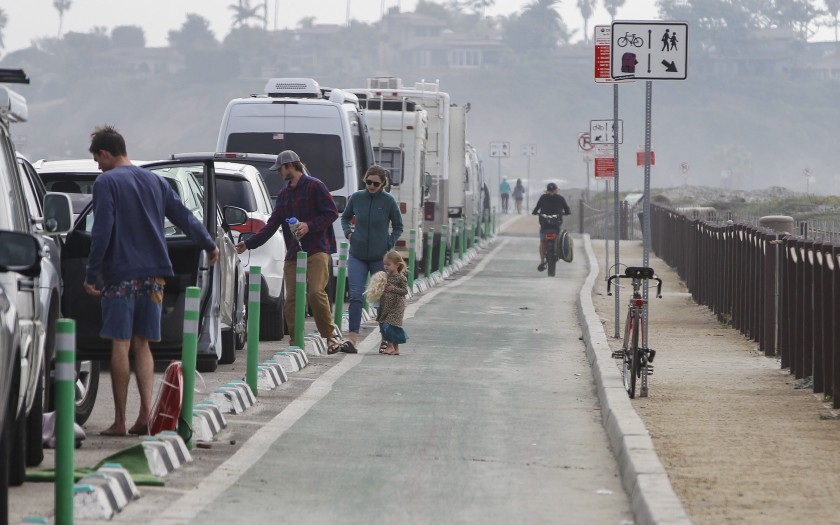The Misguided Bike Lane Dilemma
By Paul Krueger
I’m a veteran cyclist who commuted 14 miles to work and back for years. I’m fully committed to clean air, climate action, and a sensible reduction in the use of solo-driver vehicles for commuting and weekend errands.
But I’m convinced that the city’s current strategy for attaining these laudable goals is misguided, and think it has already backfired by alienating the majority of San Diegans whose support we need.
My reading of public opinion — and what I see every day on our streets — has also convinced me that only a tiny minority of San Diegans will ever even consider commuting by bike. Most live too far from their workplace, and their route includes hills, uncrossable freeways, and other barriers. They can’t carry their briefcases, lunches, and other items, including the change of clothes they’ll need at the office (which most likely doesn’t have a shower).
What about the children they drop off at school, the mid-day doctor’s appointment, the after-work meetings, the unscheduled interruptions and emergencies?
This reality-check isn’t just my opinion. SANDAG’s most recent commuter survey, from 2019, confirms that just 1.2 percent of San Diegans commute by bike, and I haven’t seen any reliable research showing that number will increase with the city’s current strategy.

But I think the biggest barrier to biking long or even short distances is safety. Bicycling is an inherently dangerous hobby. I know, because I’ve survived more than my share of collisions. I was knocked off my bike by a motorist who cruised through a stop sign. I was hit-head on by a wayward (and probably impaired) cyclist riding the wrong way on a downtown street. I broke five ribs and my collarbone when I collided with a car in May, while cycling west on Washington Street, in Hillcrest. (Lucky for me the Scripps Mercy ER was just three blocks away!)
That’s one reason why I believe no amount of lane striping, “Share The Road” signs, or “protected” bike lanes will ever convince the overwhelming majority of San Diegans that it’s safe to ride to work, or take long — or even short — trips on a bicycle.
And they’re right. The harsh truth is that we don’t have the money to insulate cyclists — or anyone — from the sad inevitably of injury and death. Last year alone, 30 San Diegans were killed by drunk or drug-impaired drivers. But we don’t put ignition-lock breathalyzers on every vehicle. We’re reading more stories about motorists — and their passengers — killed by wrong-way drivers. But we don’t line all our highway medians with concrete barriers. Airbags have killed and maimed hundreds of drivers and passengers, but we accept the trade-off for lives saved.
There’s also a spirited debate about the safety of protected bike lanes, like the ones just installed on 4th and 5th Avenues in Hillcrest. Some riders think they’re actuallyless safe than sharing the road with vehicles, because the “protected” lanes, which are bordered by curbs and stanchions, can trap a cyclist inside the lane, leaving him or her with no escape route if a pedestrian steps of the curb without looking, or a child darts into the protected lane.
I also think bike ridership is too scarce to justify the public cost of those improvements, especially when bike lanes can be accommodated — or already exist — just a block or two from those main thoroughfares. That’s one reason why I vehemently oppose the city’s ill-reasoned decision to transform the North Park’s 30th Street corridor into a cycle track. Those bike lanes wiped out hundreds of parking spots, and threaten the livelihood of restaurant and store owners who barely survived the pandemic.
Sacrificing traffic lanes for empty bike lanes also has the regrettable — but very understandable — consequence of alienating motorists stuck in slow or stopped traffic, spewing greenhouse gases from their vehicles while they curse the empty bike lanes.
But those angry motorists will have their revenge. They’ll vote “no” on the next billion-dollar transit tax, because they don’t trust how government planners will spend their money. They’ll also vote against incumbent politicians who ignore their complaints, or respond with “We know what’s best” condescension.
So how do we get public by-in for our climate action strategies?
First, our politicians need to listen to all their constituents and actively seek out their opinions. They must appoint a cross-section of the public, not just hard-core cyclists, to transportation-related boards and commissions.
Second, they must clearly communicate their plans to install bike lanes, and give residents a forum to ask questions, express their concerns, and offer alternative routes, before construction starts.
Third, they must fully consider other practical, cost-effective strategies to reduce single-vehicle commuting and be guided by the best available research, not just the loudest voices.
For example, the continuation and possible expansion of work-from-home policies, forced on us by the pandemic, should be encouraged and incentivized. Telecommuting keeps lots of motorists off our highways, and really helps reduce global warming.
Fleets of low-or non-polluting jitneys, which are very popular in San Diego’s downtown, could offer free rides around Hillcrest, North Park, La Jolla, UTC, Kearny Mesa and other busy neighborhoods.
On-demand “last mile” rides from homes and businesses to the nearest trolley or bus would encourage more use of rapid transit.
Subsidies for e-bikes — which can climb hills and carry extra items — might really increase our bike-to-work numbers.
I certainly don’t have the answers, but I can ask the questions. Thousands of my fellow San Diegans are also asking their own questions, while they’re stuck in traffic, or cutting through an alley to avoid a crowded street. Our elected officials should start listening.
Paul Krueger is a Talmadge resident, semi-retired journalist, writing coach and researcher (www.paulwkrueger.com)
He’s survived at least seven bike collisions, one or two of which were not his fault.
Category: Business, feature, Government, Life Style, Local News, Transportation







